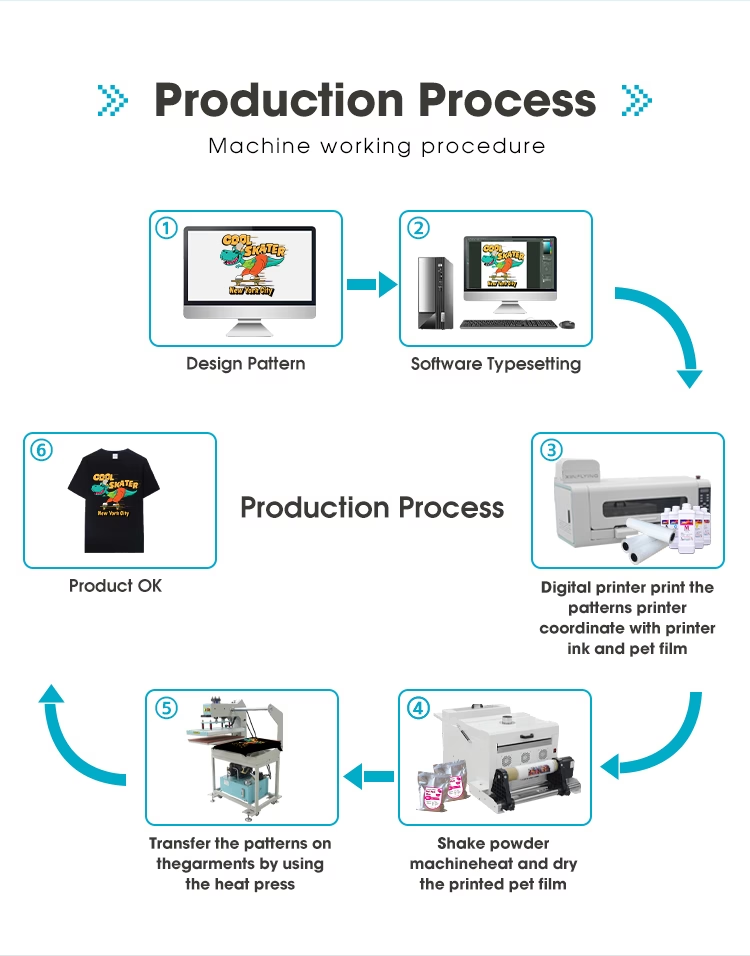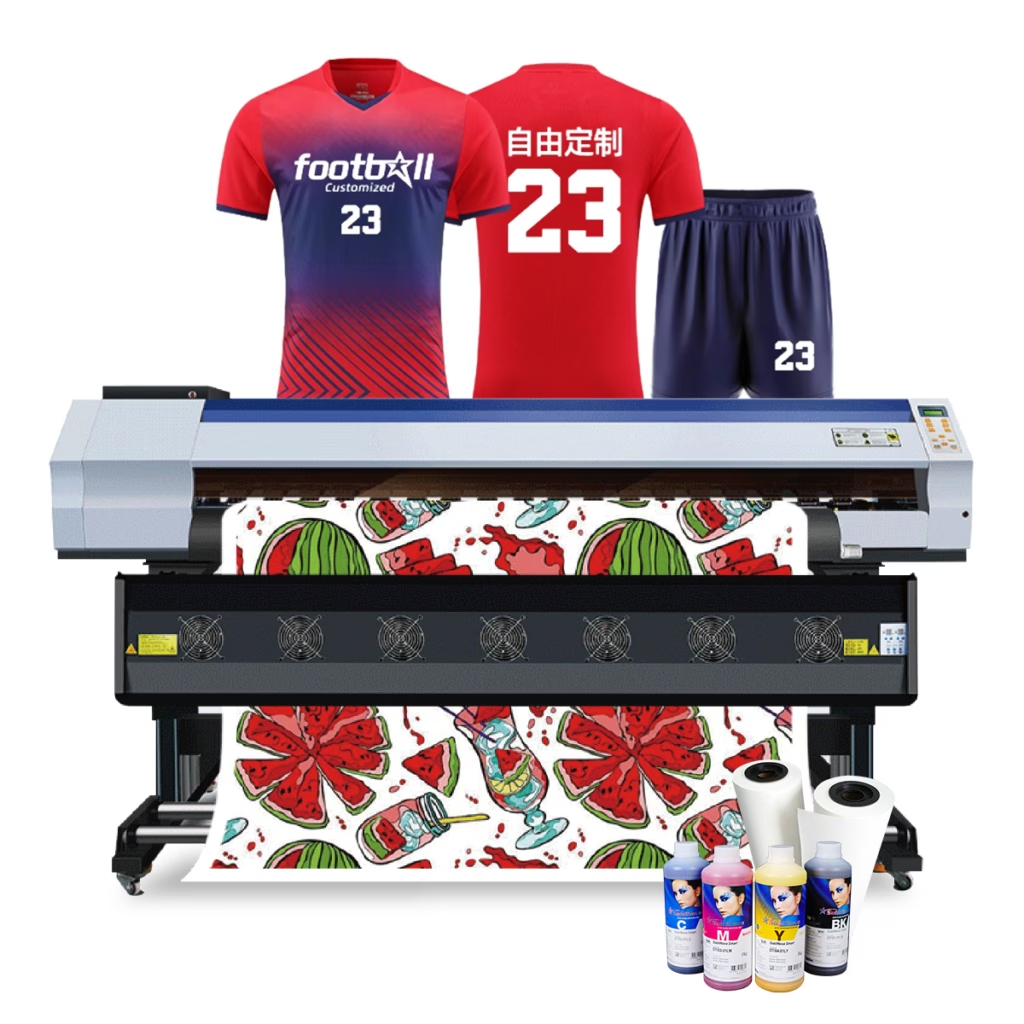DTF-Übertragungen erfreuen sich in der Druckindustrie großer Beliebtheit, revolutioniert die Art und Weise, wie Designs und Bilder auf Kleidungsstücke übertragen werden. Ein entscheidender Aspekt für die Erzielung makelloser DTF-Drucke ist der Prozess des Heißpressens. In diesem umfassenden Ratgeber, Wir tauchen in die Welt der DTF-Transfers ein und vermitteln Ihnen Schritt für Schritt, wie Sie einen DTF-Transfer heißpressen.
Was sind DTF-Übertragungen??
DTF-Übertragungen, oder Direkt-auf-Film-Übertragungen, sind ein hochmodernes Druckverfahren, das zahlreiche Vorteile gegenüber herkömmlichen Techniken bietet. Im Gegensatz zu anderen Methoden, Bei DTF-Transfers wird ein spezieller Transferfilm verwendet, der sowohl Tinte als auch Klebstoff enthält, Dies ermöglicht lebendige und langlebige Drucke. Dieser Prozess stellt sicher, dass die Farben lebendig bleiben, auch nach mehreren Wäschen, und das Bild bleibt intakt, ohne dass es zu Rissen oder Ausbleichen kommt.
So drücken Sie direkt auf Filmübertragungen?
1. Auswahl der richtigen Materialien

Beginnen Sie Ihre Reise mit dem Heißpressen von DTF-Transfers, Es ist entscheidend, die richtigen Materialien zur Hand zu haben. In erster Linie, Sie benötigen DTF-Transferpapier, das in verschiedenen Formen erhältlich ist, beispielsweise transparent, Weiß, und klebend. Diese Papiere spielen eine entscheidende Rolle bei der Übertragung des Designs auf das Kleidungsstück. Zusätzlich, Es gibt verschiedene Zubehörteile, die Sie benötigen, einschließlich DTF-Klebepulver, Heißpressmaschine und DTF-Tinte, die das reibungslose und effiziente Heißpressen unterstützen Verfahren.
2. Vorbereiten des Designs
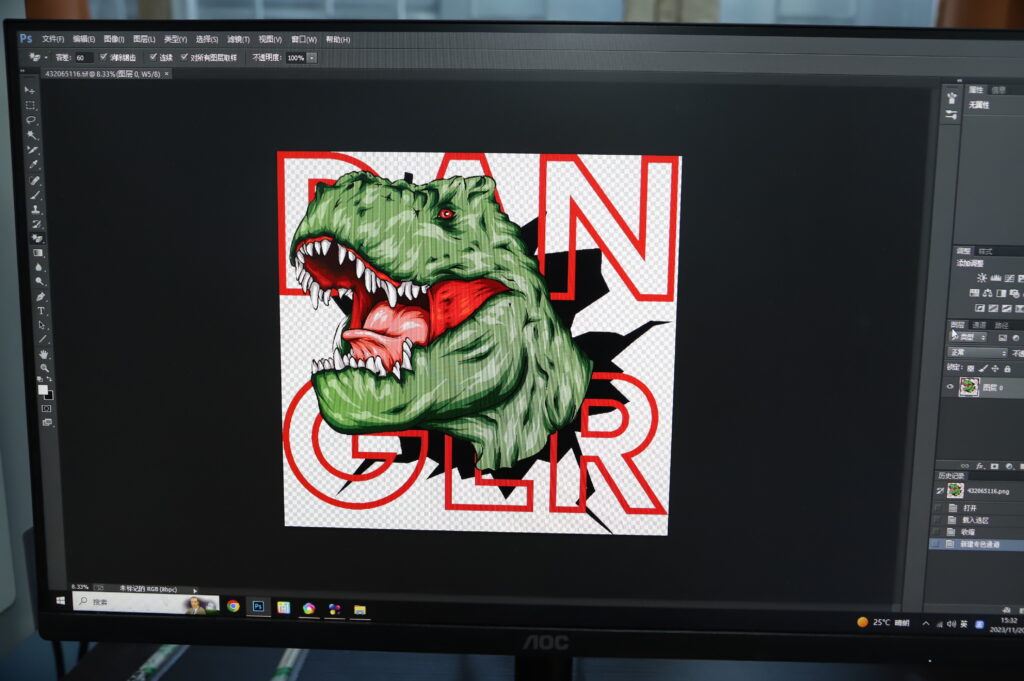
Bevor Sie mit dem Heißpressen beginnen können, Es ist wichtig, ein für DTF-Übertragungen geeignetes Design zu erstellen oder auszuwählen. Nutzen Sie Ihre Kreativität, um einzigartige und fesselnde Bilder zu entwerfen, die einen bleibenden Eindruck hinterlassen. Stellen Sie sicher, dass das Design mit dem DTF-Druck kompatibel ist und übertragen Sie es mit einem hochwertigen Drucker auf das Transferpapier. Analysieren Sie den Entwurf gründlich auf etwaige Unvollkommenheiten oder Verzerrungen, die das Ergebnis beeinträchtigen könnten.
3. Vorbereiten des Kleidungsstücks

Um eine einwandfreie DTF-Übertragung zu erreichen, Eine sorgfältige Vorbereitung des Kleidungsstücks ist der Schlüssel. Beginnen Sie mit der gründlichen Reinigung des Kleidungsstücks, um eventuellen Schmutz zu entfernen, Staub, oder Fremdkörper, die den Klebevorgang behindern könnten. Stellen Sie sicher, dass das Kleidungsstück gebügelt und flach ist, da eventuelle Knicke oder Knicke das Endergebnis negativ beeinflussen können. Das Bügeln des Kleidungsstücks vor dem Heißpressen kann dazu beitragen, eine glatte und gleichmäßige Oberfläche zu schaffen, die eine optimale Übertragung fördert.
4. Drucken der Übertragung

Jetzt ist Ihr Design fertig und das Kleidungsstück vorbereitet, Es ist Zeit, mit dem DTF-Druckverfahren zu beginnen. Beginnen Sie mit der genauen Kalibrierung der Farben, um das gewünschte Ergebnis sicherzustellen. Passen Sie die Druckereinstellungen an die Anforderungen von DTF-Übertragungen an. Abhängig vom Drucker und DTF-Transferpapier gebraucht, Möglicherweise müssen Sie einen bestimmten Druckmodus oder Papiertyp auswählen, um die Ergebnisse zu optimieren. Experimentieren ist der Schlüssel, um die perfekten Einstellungen für Ihre spezielle Kombination aus Drucker und Transferpapier zu finden.
5. Trocknen und Aushärten
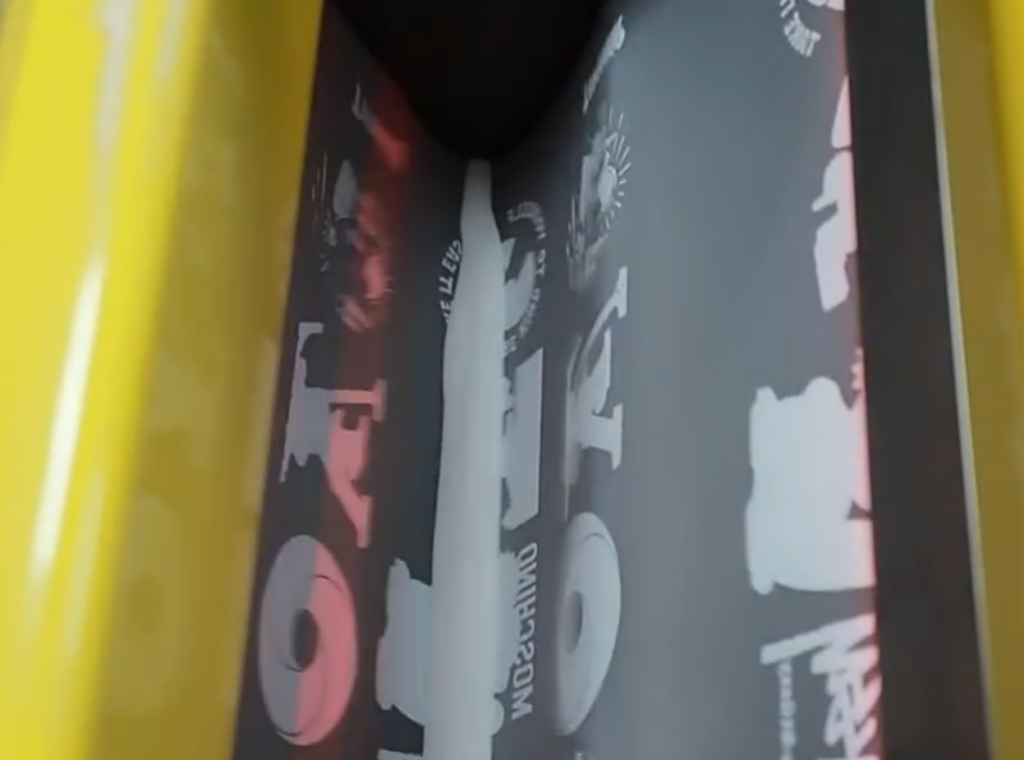
Nachdem die DTF-Übertragung gedruckt wurde, Es ist wichtig, das übertragene Bild ordnungsgemäß zu trocknen und auszuhärten. Dieser Schritt gewährleistet die Langlebigkeit und Haltbarkeit des Drucks. Zum Trocknen und Aushärten können verschiedene Methoden eingesetzt werden, inklusive Lufttrocknung, mit a Heißpressmaschine, oder unter Verwendung einer professionellen Aushärtungskammer. Für welche Methode Sie sich auch entscheiden, Für eine optimale Haftung und dauerhafte Qualität ist es unbedingt erforderlich, die Anweisungen und Richtlinien des Herstellers zu befolgen.
6. Vorbereiten der Transferpresse

Da die Heißpressmaschine eine entscheidende Rolle beim Heißpressen von DTF-Transfers auf Kleidungsstücke spielt, Sie sollten nach einem zuverlässigen und sachkundigen suchen Hersteller von Heißpressmaschinen um eine Beratung in Anspruch zu nehmen und eine Heißpressmaschine zu erwerben. Um bemerkenswerte Ergebnisse zu erzielen, ist die richtige Anpassung der Maschineneinstellungen von entscheidender Bedeutung. Nehmen Sie sich die Zeit, sich mit den Bedienelementen und Einstellungen der Transferpresse vertraut zu machen, wie zum Beispiel die Zeit, Temperatur, und Druck. Diese Variablen können das Endergebnis der Übertragung erheblich beeinflussen, Stellen Sie daher sicher, dass sie genau auf Ihre spezifischen Anforderungen kalibriert sind.
7. DTF-Transfer durch Heißpressen

Jetzt ist alles vorbereitet, Es ist Zeit, in den Heißpressprozess einzutauchen. Legen Sie das Kleidungsstück mit dem gedruckten DTF-Transfer auf die Heißpressmaschine, Stellen Sie sicher, dass es richtig positioniert ist. Wenden Sie die entsprechende Temperatur an, Zeit, und Druckeinstellungen, gemäß den Transferpapier- und Bekleidungsspezifikationen. Schließen Sie die Heißpresse vorsichtig, Stellen Sie sicher, dass die Transferfolie direkten Kontakt mit dem Kleidungsstück hat. Lassen Sie die Maschine den Pressvorgang abschließen, und entfernen Sie das übertragene Kleidungsstück vorsichtig.
8. Nachpressen und Veredeln
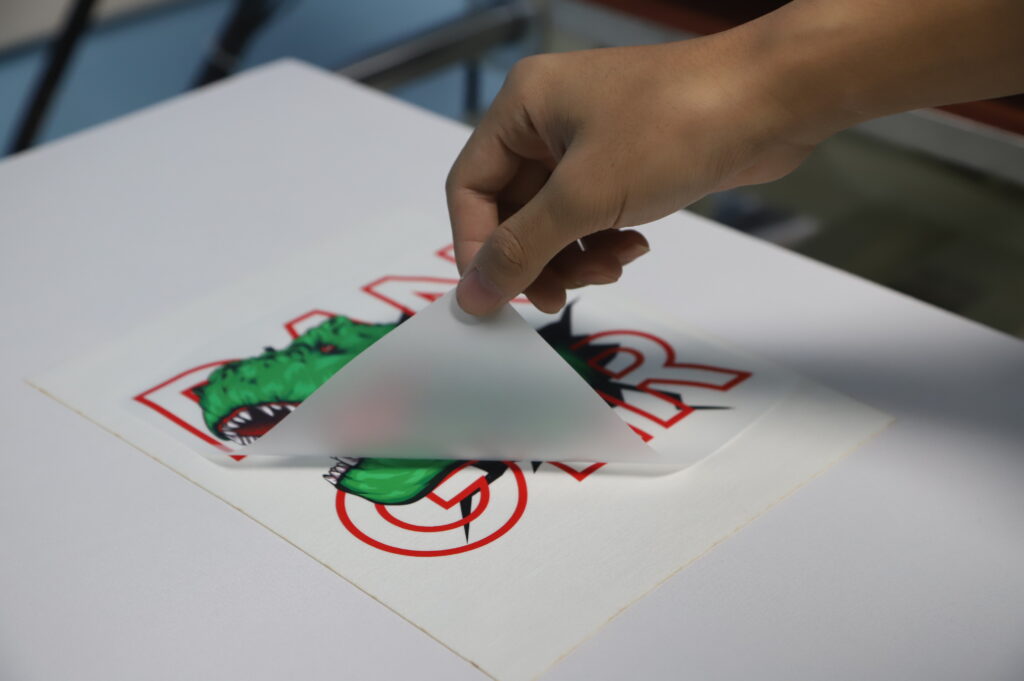
Sobald das Heißpressen abgeschlossen ist, Es ist wichtig, die entsprechenden Schritte nach dem Pressen zu befolgen, um das Aussehen und die Langlebigkeit des DTF-gedruckten Kleidungsstücks zu verbessern. Beginnen Sie mit dem vorsichtigen Abziehen der Transferfolie, Dadurch wird sichergestellt, dass das übertragene Bild intakt bleibt. Reinigen Sie das übertragene Kleidungsstück mit einem sanften Reinigungsmittel, um Rückstände oder überschüssige Tinte zu entfernen. Endlich, Erwägen Sie, das Erscheinungsbild und die Haltbarkeit des Drucks weiter zu verbessern, indem Sie zusätzliche Veredelungstechniken anwenden, z. B. das Auftragen einer Schutzschicht oder die Verwendung einer Heißpressmaschine für einen zweiten Aushärtungsprozess.
FAQs zu häufigen Problemen
1. Warum haften meine DTF-Transfers beim Heißpressen nicht richtig??
Die Behebung von Haftungsproblemen bei DTF-Übertragungen während des Heißpressens kann auf mehrere Faktoren zurückgeführt werden. Stellen Sie sicher, dass die Oberfläche sauber und frei von Schmutz ist, Öle, oder Fremdkörper, die die Haftung behindern könnten. Auch, Pressen Sie Kleidungsstücke vor, um Feuchtigkeit und Falten zu entfernen. Passen Sie die Temperatur an, Druck, und Presszeit entsprechend den Transfervorgaben. zuletzt, bei Verwendung einer farbigen Grundschicht, Achten Sie auf eine ordnungsgemäße Aushärtung bzw. Kompatibilität mit der Transferfolie, da unsachgemäße Kombinationen zu Haftungsproblemen führen können.
2. Wie kann ich verhindern, dass Farben nach dem Heißpressen von DTF-Transfers ausbluten oder verschmieren??
Um Farbausblutungen oder Verschmierungsprobleme nach dem Heißpressen von DTF-Transfers zu vermeiden, Stellen Sie sicher, dass die Transferfolie und die bedruckte Seite des Transferpapiers beim Anpressen direkten Kontakt haben, jede Bewegung verhindern. Druck anpassen, Temperatur, und Presszeit gemäß Transfervorgaben. Wenn die Farben immer noch ausbluten, Erwägen Sie, den Druck zu verringern oder die Presszeit zu verlängern. Erinnern, Durch die Verwendung hochwertiger Transferfolien und die sorgfältige Befolgung der Herstelleranweisungen kann das Ausbluten oder Verschmieren der Farbe deutlich minimiert werden.
3. Meine DTF-Transfers erscheinen nach dem Heißpressen verblasst oder es fehlt ihnen an Lebendigkeit; Wie kann ich das verbessern??
Wenn DTF-Transfers nach dem Heißpressen verblasst oder nicht lebendig erscheinen, Erwägen Sie, die Temperatur und die Presszeit anzupassen. Eine leichte Erhöhung der Temperatur oder eine Verlängerung der Presszeit um einige Sekunden kann die Farbbrillanz verbessern. Zusätzlich, Achten Sie darauf, dass die Transferfolie für den Untergrund und das Transferverfahren geeignet ist. Befolgen Sie genau die Anweisungen des Folienherstellers, einschließlich empfohlener Temperaturbereiche und Presszeiten, kann zu lebendigen und langanhaltenden Übertragungen führen.
4. Wie kann ich Bildverzerrungen oder Unschärfen auf meinen DTF-Transfers beim Heißpressen verhindern??
Um Bildverzerrungen oder Unschärfe bei DTF-Übertragungen zu verhindern, Stellen Sie vor dem Heißpressen sicher, dass sowohl die Transferfolie als auch das Substrat richtig ausgerichtet sind. Verwenden Sie Passmarken oder Ausrichtungshilfen, um eine genaue Positionierung sicherzustellen. Vermeiden Sie übermäßige Bewegungen oder Verschiebungen beim Positionieren der Transferfolie. Auch eine Erhöhung des Drucks beim Pressen kann dazu beitragen, Bewegungen zu verhindern, Dies führt zu scharfen und verzerrungsfreien Übertragungen.
5. Warum sind auf meinen DTF-Transfers nach dem Heißpressen Streifen oder Linien sichtbar??
Streifen oder Linien auf DTF-Transfers nach dem Heißpressen können auf unzureichenden Druck oder das Vorhandensein von Ablagerungen auf dem Substrat hinweisen. Stellen Sie sicher, dass der Untergrund sauber und frei von Partikeln ist, die eine Streifenbildung verursachen könnten. Erwägen Sie, den Druck beim Pressen zu erhöhen, Gewährleistung eines ordnungsgemäßen Kontakts zwischen der Transferfolie und dem Substrat. Das Experimentieren mit verschiedenen Druckeinstellungen kann dabei helfen, Streifenbildung zu vermeiden und die Gesamtqualität des übertragenen Bildes zu verbessern.
6. Was soll ich tun, wenn sich meine DTF-Transfers nach dem Heißpressen ablösen oder Risse bekommen??
Ein Abblättern oder Reißen der DTF-Transferfolien nach dem Heißpressen kann auf eine unzureichende Presszeit oder -temperatur zurückzuführen sein. Stellen Sie sicher, dass die Transferpresse den empfohlenen Temperaturbereich erreicht, der für die Transferfolie angegeben ist. Passen Sie die Presszeit entsprechend an, Befolgen Sie die Richtlinien des Herstellers. Zusätzlich, Überprüfen Sie noch einmal die Kompatibilität von Transferfolie und Untergrund, sicherzustellen, dass sie zueinander passen. Eine ordnungsgemäße Aushärtung durch ausreichend Hitze und Druck ist wichtig, um Probleme mit Abblättern oder Rissen zu vermeiden.
Abschluss
Um die Kunst des Heißpressens von DTF-Transfers zu beherrschen, ist ein umfassendes Verständnis des Prozesses sowie der richtigen Materialien und Techniken erforderlich. Indem Sie dieser Schritt-für-Schritt-Anleitung folgen, Erschließen Sie grenzenlose Möglichkeiten und erzielen Sie bemerkenswerte Ergebnisse in der Welt des DTF-Transferdrucks. Lassen Sie Ihrer Kreativität freien Lauf, Experimentieren Sie mit verschiedenen Ansätzen, und verbessern Sie kontinuierlich Ihre Fähigkeiten, um Ihr wahres Potenzial im Bereich der DTF-Transfers freizusetzen. Zögern Sie nicht länger – Tauchen Sie ein und lassen Sie Ihrer Fantasie freien Lauf!


